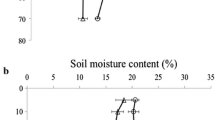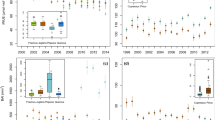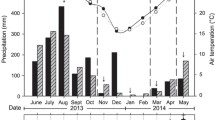Abstract
Aims
Intercropping in plantations can improve ecosystem services, but its potential effects on trees’ water use and production are concerns due to increases in water scarcity related to climate change. The aim of this study was to address these concerns by exploring water uptake responses of jujube (Ziziphus jujuba Mill.) trees to intercropping and extremely dry periods on the semi-arid Loess Plateau of China.
Methods
Natural stable isotopes (2H and 18O) were analysed to characterize water use patterns of jujube trees and intercrops in the main tree and crop root overlap layer (ROL, 0–120 cm). 10% stable deuterated water was injected at three targeted depths (2, 3 and 4 m) to characterize the water uptake of jujube trees below the main root overlap layers (BOL).
Results
In ROL, intercropped jujube trees obtained higher proportions of water in shallower and deeper layers than monocultured jujube trees during wet and dry periods, respectively. Proportional contributions of soil layers to the trees’ water uptake were positively correlated with the layers’ water amount ratios (relative to the entire profile) in intercropped orchards but not in monoculture. In some extremely dry periods, intercropping resulted in jujube trees absorbing deeper water (up to 3 m) in BOL.
Conclusions
At the early stage of land-use change from plantation to agroforestry, intercrops induce jujube trees to absorb higher proportions of water from soil layers with high proportions of total water contents in ROL. The soil water in BOL is an important buffer for maintaining water supplies for tree growth in agroforestry systems in case of extreme drought.







Similar content being viewed by others
References
Barnard RL, de Bello F, Gilgen AK, Buchmann N (2006) The δ18O of root crown water best reflects source water δ18O in different types of herbaceous species. Rapid Commun Mass Spectrom 20:3799–3802
Beyer M, Koeniger P, Gaj M, Hamutoko JT, Wanke H, Himmelsbach T (2016) A deuterium-based labeling technique for the investigation of rooting depths, water uptake dynamics and unsaturated zone water transport in semiarid environments. J Hydrol 533:627–643
Beyer M, Hamutoko JT, Wanke H, Gaj M, Koeniger P (2018) Examination of deep root water uptake using anomalies of soil water stable isotopes, depth-controlled isotopic labeling and mixing models. J Hydrol 566:122–136
Canadell J, Jackson RB, Ehleringer JR, Mooney HA, Sala OE, Schulze ED (1996) Maximum rooting depth of vegetation types at the global scale. Oecologia 108:583–595
Cardinael R, Mao Z, Prieto I, Stokes A, Dupraz C, Kim JH, Jourdan C (2015) Competition with winter crops induces deeper rooting of walnut trees in a Mediterranean alley cropping agroforestry system. Plant Soil 391:219–235
Celette F, Gaudin R, Gary C (2008) Spatial and temporal changes to the water regime of a Mediterranean vineyard due to the adoption of cover cropping. Eur J Agron 4:153–162
Chen C, Liu W, Wu J, Jiang X, Zhu X (2019) Can intercropping with the cash crop help improve the soil physico-chemical properties of rubber plantations? Geoderma 335:149–160
Dai Y, Zheng XJ, Tang LS, Li Y (2015) Stable oxygen isotopes reveal distinct water use patterns of two Haloxylon species in the Gurbantonggut Desert. Plant Soil 389:73–87
Dawson TE, Pate JS (1996) Seasonal water uptake and movement in root systems of Australian phraeatophytic plants of dimorphic root morphology: a stable isotope investigation. Oecologia 107:13–20
Eggemeyer KD, Awada T, Harvey FE, Wedin DA, Zhou X, Zanner CW (2009) Seasonal changes in depth of water uptake for encroaching trees Juniperus virginiana and Pinus ponderosa and two dominant C4 grasses in a semiarid grassland. Tree Physiol 29:157–169
Ehleringer JR, Dawson TE (1992) Water uptake by plants: perspectives from stable isotope composition. Plant Cell Environ 15:1073–1082
Feng ZM, Yang YZ, Zhang YQ, Zhang PT, Li YQ (2005) Grain-for-green policy and its impacts on grain supply in West China. Land Use Policy 22:301–312
Fernández ME, Gyenge JE, Schlichter TM (2006) Balance of competitive and facilitative effects of exotic trees on a native Patagonian grass. Plant Ecol 188:67–76
Fernández ME, Gyenge JE, Licata J, Schlichter T, Bond BJ (2008) Belowground interactions for water between trees and grasses in a temperate semiarid agroforestry system. Agrofor Syst 74:185–197
Gao LB, Xu HS, Bi HX, Bao B, Wang XY, Bi C (2013) Intercropping competition between apple trees and crops in agroforestry systems on the loess plateau of China. PLoS One 8:e70739
Gao XD, Wu PT, Zhao XN, Wang JW, Shi YG (2014) Effects of land use on soil moisture variations in a semi-arid catchment: implications for land and agricultural water management. Land Degrad Dev 25:163–172
Gao XD, Zhao XN, Li HC, Guo L, Lv T, Wu PT (2018) Exotic shrub species (Caragana korshinskii) is more resistant to extreme natural drought than native species (Artemisia gmelinii) in a semiarid revegetated ecosystem. Agric For Meteorol 263:207–216
Green SR, Clothier BE (1995) Root water uptake by kiwifruit vines following partial wetting of the root zone. Plant Soil 173:317–328
Green SR, Clothier BE, McLeod DJ (1997) The response of sap flow in apple roots to located irrigation. Agric Water Manag 33:63–78
Grossiord C, Gessler A, Granier A, Berger S, Bréchet C, Hentschel R, Hommel R, Scherer-Lorenzen M, Bonal D (2014) Impact of interspecific interactions on the soil water uptake depth in a young temperate mixed species plantation. J Hydrol 519:3511–3519
Grossiord C, Sevanto S, Dawson TE, Adams HD, Collins AD, Dickman LT, Newman BD, Stockton EA, McDowell NG (2017) Warming combined with more extreme precipitation regimes modifies the water sources used by trees. New Phytol 213:584–596
Huang J, Yu H, Dai A, Wei Y, Kang L (2017) Drylands face potential threat under 2 °C global warming target. Nat Clim Chang 7:417–422
Huo GP, Zhao XN, Gao XD, Wang SF, Pan YH (2018) Seasonal water use patterns of rainfed jujube trees in stands of different ages under semiarid plantations in China. Agric Ecosyst Environ 265:392–401
Jia Z, Zhu Y, Liu L (2012) Different water use strategies of juvenile and adult Caragana intermedia plantations in the Gonghe Basin, Tibet plateau. PLoS One 7:e45902
Jiang JG, Huang XJ, Chen J, Lin QS (2007) Comparison of the sedative and hypnotic effects of flavonoids, asponins, and polysaccharides extracted from semen Ziziphus jujube. Taylor & Francis 21:310–320
Jose S (2009) Agroforestry for ecosystem services and environmental benefits: an overview. Agrofor Syst 76:1–10
Kulmatiski A, Beard KH, Richard JTV, February EC (2010) A depth-controlled tracer technique measures vertical, horizontal and temporal patterns of water use by trees and grasses in a subtropical savanna. New Phytol 188:199–209
Li J (1999) Cultivation and management techniques of Hemerocallis fulva (in Chinese). Agric Technol Inf 10:12–13
Li J, Chen B, Li XF, Zhao YJ, Ciren YJ, Jiang B, Hu W, Cheng JM, Shao MA (2008) Effects of deep soil desiccation on artificial forestlands in different vegetation zones on the loess plateau of China. Acta Ecol Sin 28:1429–1445
Li LS, Gao XD, Wu PT, Zhao XN, Li HC, Ling Q, Sun WH (2017) Soil water content and root patterns in a rain-fed jujube plantation across stand ages on the loess plateau of China. Land Degrad Dev 28:207–216
Lin BB (2010) The role of agroforestry in reducing water loss through soil evaporation and crop transpiration in coffee agroecosystems. Agric For Meteorol 150:510–518
Lin S, Wang Y (2007) Spatial-temporal evolution of precipitation in China loess plateau. J Desert Res 3:502–508
Ling Q, Gao XD, Zhao XN, Huang J, Li HC, Li LS, Sun WH, Wu PT (2017) Soil water effects of agroforestry in rainfed jujube (Ziziphus jujube mill.) orchards on loess hillslopes in Northwest China. Agric Ecosyst Environ 247:343–351
Liu GB (1999) Soil conservation and sustainable agriculture on the loess plateau: challenges and prospects. Ecosyst Res Manag China 8:663–668
Liu L, Gan Y, Bueckert R, Rees K (2011a) Rooting systems of oilseed and pulse crops. II: vertical distribution patterns across the soil profile. Field Crop Res 122:248–255
Liu YH, Xu Z, Duffy R, Chen WL (2011b) Analyzing relationships among water uptake patterns, rootlet biomass distribution and soil water content profile in a subalpine shrubland using water isotopes. Eur J Soil Biol 47:380–386
Meinzer FC, Brooks JR, Domec JC, Gartner BL, Warren JM, Woodruff DR, Bible K, Shaw DC (2006) Dynamics of water transport and storage in conifers studied with deuterium and heat tracing techniques. Plant Cell Environ 29:105–114
Nnyamah JU, Black TA (1997) Rates and patterns of water uptake in a Douglas-fir forest. Soil Sci Soc Am J 41:972–979
Orlowski N, Frede HG, Brüggemann N, Breuer L (2013) Validation and application of a cryogenic vacuum extraction system for soil and plant water extraction for isotope analysis. J SensorsSensor Syst 2:179–193
Parnell A, Inger R, Bearhop S, Jackson AL (2008) SIAR: stable isotope analysis in R
Payn T, Carnus J, Freer-Smith P, Kimberley M, Kollert W, Liu S, Orazio C, Rodriguez L, Silva LN, Wingfield MJ (2015) Changes in planted forests and future global implications. For Ecol Manag 352:57–67
Porporato A, Daly E, Rodriguez-Iturbe I (2004) Soil water balance and ecosystem response to climate change. Am Nat 164:625–632
Sanchez PA (1995) Science in agroforestry. Agrofor Syst 30:5–55
Schwab N, Schickhoff U, Fischer E (2015) Transition to agroforestry significantly improves soil quality: a case study in the central mid-hills of Nepal. Agric Ecosyst Environ 205:57–69
Song XL, Gao XD, Zhao XN, Wu PT, Dyck M (2017) Spatial distribution of soil moisture and fine roots in rain-fed apple orchards employing a rainwater collection and infiltration (RWCI) system on the loess plateau of China. Agric Water Manag 184:170–177
Vesterdal L, Schmidt IK, Callesen I, Nilsson LO, Gundersen P (2008) Carbon and nitrogen in forest floor and mineral soil under six common European tree species. For Ecol Manag 255:35–48
Wang J, Fu B, Lu N, Zhang L (2017) Seasonal variation in water uptake patterns of three plant species based on stable isotopes in the semi-arid loess plateau. Sci Total Environ 609:27–37
Wang J, Lu N, Fu B (2019) Inter-comparison of stable isotope mixing models for determining plant water source partitioning. Sci Total Environ 666:685–693
Williams DG, Ehleringer JR (2000) Intra- and interspecific variation for summer precipitation use in pinyon-juniper woodlands. Ecol Monogr 70:517
Wu J, Liu W, Chen C (2016) Can intercropping with the world's three major beverage plants help improve the water use of rubber trees? J Appl Ecol 53:1787–1799
Wu J, Liu W, Chen C (2017) How do plants share water sources in a rubber-tea agroforestry system during the pronounced dry season? Agric Ecosyst Environ 236:69–77
Xin XG, Wu PT, Wang YK, Lin J (2012) A model for water consumption by mountain jujube pear-like. Acta Ecol Sin 32:7473–7482
Yang B, Wen X, Sun X (2015) Seasonal variations in depth of water uptake for a subtropical coniferous plantation subjected to drought in an east Asian monsoon region. Agric For Meteorol 201:218–228
Acknowledgements
This research was financially supported by the National Key Research and Development Program (grant no. 2016YFC0400204), the National Natural Science Foundation of China (grant no. 41771316), the Shaanxi Innovative Research Team for Key Science and Technology (grant no. 2017KCT-15), the ‘111’ Project (grant no. B12007), and CAS "Youth Scholar of West China" Program (XAB2018A04). We thank Dr. Marie Gosme for useful comments on the manuscript.
Author information
Authors and Affiliations
Corresponding author
Additional information
Responsible Editor: Zhun Mao.
Publisher’s note
Springer Nature remains neutral with regard to jurisdictional claims in published maps and institutional affiliations.
Rights and permissions
About this article
Cite this article
Huo, G., Zhao, X., Gao, X. et al. Seasonal effects of intercropping on tree water use strategies in semiarid plantations: Evidence from natural and labelling stable isotopes. Plant Soil 453, 229–243 (2020). https://doi.org/10.1007/s11104-020-04477-5
Received:
Accepted:
Published:
Issue Date:
DOI: https://doi.org/10.1007/s11104-020-04477-5




